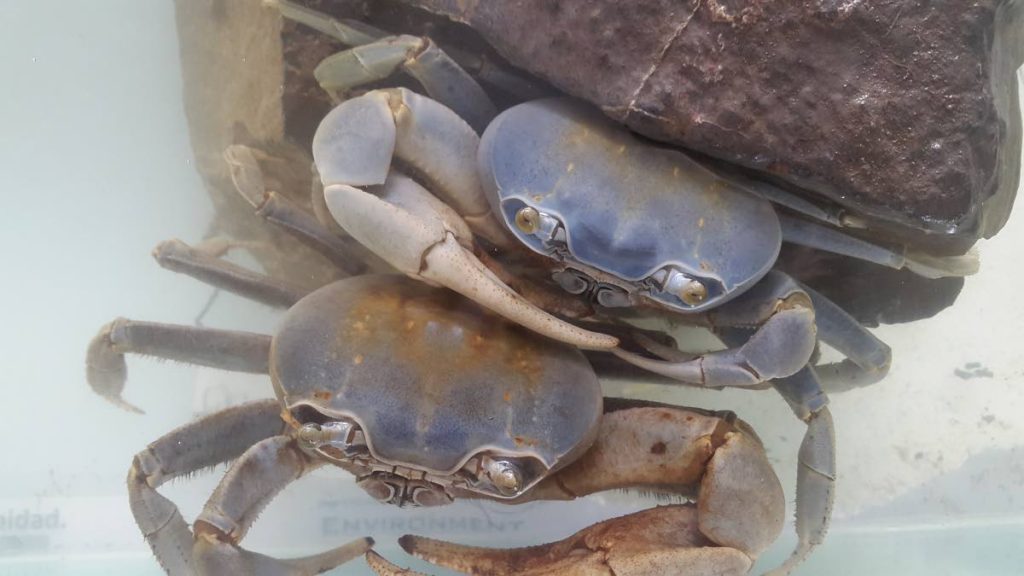Crabs! Not just a delectable meal

Delezia Shivani Singh
You are probably familiar with crabs as that key ingredient to compliment your callaloo. Or perhaps you prefer them served with dumplings.
Indeed, this diverse group of crustaceans represents a well-known food item in a range of local, regional and international crab dishes, with many species having gained economic status from crab cuisine popularity. Whatever the species of choice may be, many people in TT would have tasted these delectable decapods and enjoyed them, despite the painstaking chore of having to remove the outer shell before actually enjoying the meat. As such, you may have even familiarised yourself with the anatomy of crabs, for the sake of preparing and eating them. But have you ever given thought to where these tasty organisms came from or their biological roles in the natural environment?
A common perception is that crabs are merely scavengers with indiscriminate diets that will eat anything available. Crabs are certainly resourceful foragers but there is a lot more to them than just being the “vultures” of the aquatic biome. Most species are opportunistic feeders with many types having a generally low specialisation in diet. Variation in diet can still arise from the tendency of a particular group to have a preference toward certain food types such as carrion or animal based food. For instance, carnivorous types such as the marine/brackish species (Callinectes sapidus) prey on mollusks, polychaete worms and other marine invertebrates.

Locally these are referred to as “ciriques” and are prime targets for recreational crab-catching, mainly caught by crab pots, baited lines and seining for later consumption. This group of crabs has been recognised for its economic value. However, these carnivorous crabs perform a key ecological role as predators as well, regulating epibenthos populations (organisms dwelling at the near surface of bottom sediments) and can even influence the composition of the epifaunal communities. They are also food for a number of predators such as commercially important fish species like croakers (“Cro Cro”), wetland birds such as herons and of course, humans.
Alternatively, herbivorous crabs fill the role of proficient processors of low nutrient food sources, supporting essential food chain links in generally low productivity systems. For example, a cultural favourite in local dishes is the mangrove crab, Ucides cordatus or “hairy” land crab, which feeds on mangrove leaf litter; which most herbivores and decomposers find unpalatable.

The shredding action of Ucides cordatus on litter fall contributes to the mangrove detritus, making nutrients available to other consumers and indirectly maintaining productivity in mangrove ecosystems. This species is so efficient in these coastal forests that they have been thought to match, and even exceed, productivity facilitated by other litter consuming crabs (such as the Indo-Pacific sesarmids). The “iron back” or blue land crab (Cardisoma guanhumi) is another land crab of commercial value, this being the main element in the traditional crab and dumpling dish. This species is more omnivorous in nature, feeding on leaves, insects and decaying matter. While both the hairy and blue land crabs are sources of income for local crab vendors, a report by the Centre for Resource Management and Environmental Studies, UWI, Cavehill in 2014 warned of the exploitation and over harvesting of these crabs, as the fishery tends to involve both unchecked small scale and recreational harvesting. A lot is still unknown about the population status of these species and the ecosystem services they provide.

Freshwater crabs are also generally omnivorous, consuming an array of aquatic plants, benthic invertebrates, fish and even seeds! Similar to the land and marine relatives, freshwater crabs have both predatory and prey roles making this group equally significant to the aquatic and terrestrial communities that they are a part of.
Our local mountain crab, Rodriguezus garmani, is prey for local mammals such as opposums (Didelphys marsupialis insularis) and tayras (Eira barbara) while being a formidable predator to freshwater stream fauna, snakes, lizards and even individuals of its own kind.
Aside from having prey and predatory functions, Rodriguezus garmani and other close freshwater relatives have been recognised as key indicators of water quality for aquatic habitats since these species generally reside in pristine riverine conditions. This group can also form a crucial link in both aquatic and terrestrial food chains, where they function as detritivores feeding on dead or decaying organic matter, assisting in the decomposition process and nutrient cycling in freshwater systems. Rodriguezus garmani crabs are harvested locally and sold for consumption, but concern also surrounds this edible species since population status needs verifying. The life span of these mountain crabs can exceed two years, indicating that crabs may take some time to become sexually mature. This makes the species vulnerable to the threat of over harvesting since immature crabs may be caught without having a chance to reach sexual maturity, thus being deprived the opportunity to breed.
So the next time you crack into a cooked crab be sure to reflect on the importance of this intriguing creature to its natural environment. Whether they are resourcefully shredding mangrove leaves or providing you with your next meal, we should all appreciate these remarkable crustaceans for their important roles in the terrestrial and aquatic ecosystems.
* For more information on our natural environment, you can contact the TT Field Naturalists’ Club at admin@ttfnc.org or visit our website at www.ttfnc.org and our Facebook or YouTube pages.

Comments
"Crabs! Not just a delectable meal"